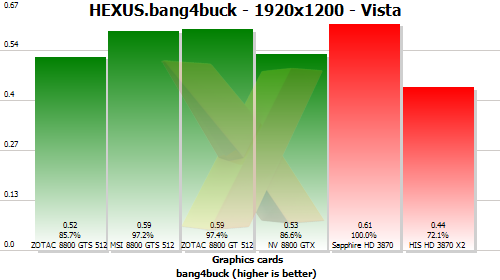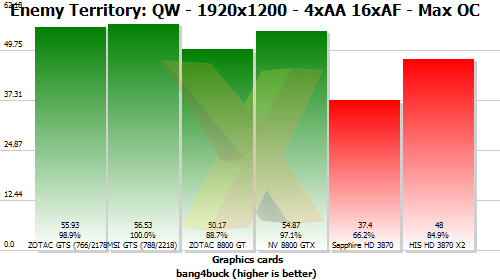HEXUS.bang4buck, and overclocking
HEXUS.bang4buck - Vista suite.
In a rough-and-ready assessment of the cards' bang per buck, we've aggregated the 1920x1200 frame rates for the three games, normalised them* and taken account of listed the cards' prices.
But there are more provisos than we'd care to shake a stick at. We could have chosen three different games, the cards' prices could have been derived from other sources and pricing tends to fluctuate daily.
Consequently, the table and graph below highlight a metric that should
only be used as a yardstick for evaluating comparative performance with
price factored in. Other architectural benefits are not covered,
obviously.
| Graphics cards | ZOTAC GeForce 8800 GTS 512MiB AMP! Edition | MSI NX8800GTS-T2D512E-OC 512MiB | ZOTAC GeForce 8800 GT 512MiB AMP! Edition | NVIDIA GeForce 8800 GTX 768MiB | ATI Radeon HD 3870 512MiB | ATI Radeon HD 3870 X2 1,024MiB |
|---|---|---|---|---|---|---|
| Actual aggregate marks at 1920x1200 | 158.21 | 158.21 | 153.55 | 156.75 | 107.04 | 173.77 |
| Aggregate marks, normalised*, at 1920x1200 | 119.85 | 119.85 | 118.16 | 124.04 | 82.76 | 127.88 |
| Current price | £229 | £202 | £199 | £235 | £135 | £290 |
| HEXUS.bang4buck score at 1920x1200 | 0.523 | 0.593 | 0.594 | 0.528 | 0.61 | 0.44 |
| Acceptable frame rate (av. 60fps) at 1920x1200 | No (ET, LP) | No (ET, LP) | No (ET, LP) | No (ET, LP) | No (CoH, ET,LP) | No (ET, LP) |
* The normalisation refers to taking playable frame rate into account. Should a card benchmark at over 60 frames per second in any one game, the extra fps count as half. Similarly, should a card benchmark lower, say at 40fps, we deduct half the difference from its average frame rate and the desired 60fps, giving it a bang4buck score of 30 marks. The minimum allowable frame rate is 20fps but that scores zero.
As an example, should a card score 120fps we treat it as 90fps as only half the frame rate above 60fps is counted for the bang4buck - this is the formula: (120-((120-60)/2)). Similarly, should it score 30fps, we count it as only 15fps: (30+((30-60)/2)).
The reasoning behind such calculation lies with playable frame rates.
Should card A score 110fps in a benchmark and card B 160, then card B would otherwise receive an extra 50 marks in our bang4buck assessment, even though both cards produce perfectly playable frame rates and anything above 60fps is a bonus and not a necessity for most.
Similarly, without our adjustments, the aggregated bang4buck total for two very different cards would be identical if, in a further benchmark, card A scored a smooth 70fps and card B an unplayable 20fps. Both would win marks totally 180, yet the games-playing experience would be vastly different.
A more realistic (and useful) assessment would say that card A is better because it ran smoothly in both games - and that view would be accurately reflected in our adjusted aggregation, where card A would receive 150 marks (85+65) and card B 100 (100+0).
In effect, we're including a desired average frame rate, in this case 60, and penalising lower performance while giving frame rates higher than 60fps only half as much credit as those up to 60fps. If this doesn't make sense or you have issue with it, please hit the HEXUS community.
Here's the HEXUS.bang4buck graph at 1,920x1,200.

The graph divides the normalised score by the price.
The MSI's attractive £202 e-tail price ensures that it looks more favourable than the equivalently-clocked ZOTAC. Further, the MSI's better bundle isn't taken into account here.
Sapphire's Radeon HD 3870 512MiB doesn't benchmark as well as
the GTS 512, sure, but its £135 price and reasonable
performance makes it look the best in our bang4buck graph.
Overclocking

Both GTS 512 cards ran way past their pre-overclocked specifications when subject to a bout of overclocking.
We managed to hit rock-solid frequencies of 766/2,178 and 788/2,218 for the ZOTAC and MSI cards, respectively. Enemy Territory: Quake Wars was re-run at 1,920x1,200.
The elevated frequencies are enough for both cards to eclipse the memory-bandwidth deficit that they face against the venerable GeForce 8800 GTX.









